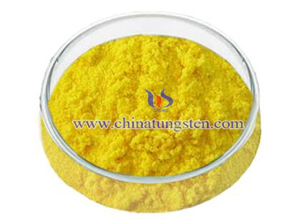Nanometer Tungsten Trioxide Photocatalyst Paper-Based Bamboo Curtain
- Details
- Category: Tungsten Information
- Published on Wednesday, 25 May 2016 18:04
 As the changing of live and work patterns, the time neoteric stay in the indoor environment is increasingly extended, almost more than 90% of the time spent indoors. New building materials especially synthetic building materials are widely used in modern building, and the indoor air quality is seriously declined. Photocatalyst is the general optical semiconductor material which represented by nanoscale titanium dioxide with a photocatalytic function, and being one of the safest material on the international governance of indoor environmental pollution. Mechanism of photocatalyst is that dielectric material generates electron-positron charges under light, and decomposes the water in the air into hydrogen ions, thus results in decomposition reduction.
As the changing of live and work patterns, the time neoteric stay in the indoor environment is increasingly extended, almost more than 90% of the time spent indoors. New building materials especially synthetic building materials are widely used in modern building, and the indoor air quality is seriously declined. Photocatalyst is the general optical semiconductor material which represented by nanoscale titanium dioxide with a photocatalytic function, and being one of the safest material on the international governance of indoor environmental pollution. Mechanism of photocatalyst is that dielectric material generates electron-positron charges under light, and decomposes the water in the air into hydrogen ions, thus results in decomposition reduction.
Textile, wood materials are widely used in interior decoration, furniture and other fields, their environmental protection concerned particularly to the community. Studies indicate a method for preparing nanometer tungsten trioxide photocatalyst paper-based bamboo curtain, which base as follows:
1. Preparation of aqueous emulsion of nano tungsten oxide photocatalyst: Heat the ammonium tungstate solution under 50~80°C, then add ethanol after cooling to form the firstly liquid latex; cationic surfactant is added to protect the colloid, then get the secondary liquid latex by mechanical refining immiscibility;
2. Preparation of paper-based bamboo curtain: Complexing the bamboo curtain and paper based fiber to obtain the paper-based bamboo curtain;
3. Spraying the secondary latex onto the paper-based bamboo curtain to form a film, thus to obtain the needed nanometer tungsten trioxide photocatalyst paper-based bamboo curtain.
Such paper-based bamboo curtain takes tungsten trioxide as a photocatalyst material. Since tungsten trioxide has the low band gap (2.4eV~2.8eV), and achieve better visible degradation, also with the relatively high light conversion efficiency. Valence band holes (H+) makes the oxidation of adsorbed water molecules, the conduction band electrons (e-) reduces oxygen in the air, thereby oxidizing and decomposing organic and bacteria organic.
| Tungsten Oxide Supplier: Chinatungsten Online www.tungsten-oxide.com | Tel.: 86 592 5129696; Fax: 86 592 5129797;Email:sales@chinatungsten.com |
| Tungsten News & Prices, 3G Version: http://3g.chinatungsten.com | Molybdenum News & Molybdenum Price: http://news.molybdenum.com.cn |



 sales@chinatungsten.com
sales@chinatungsten.com